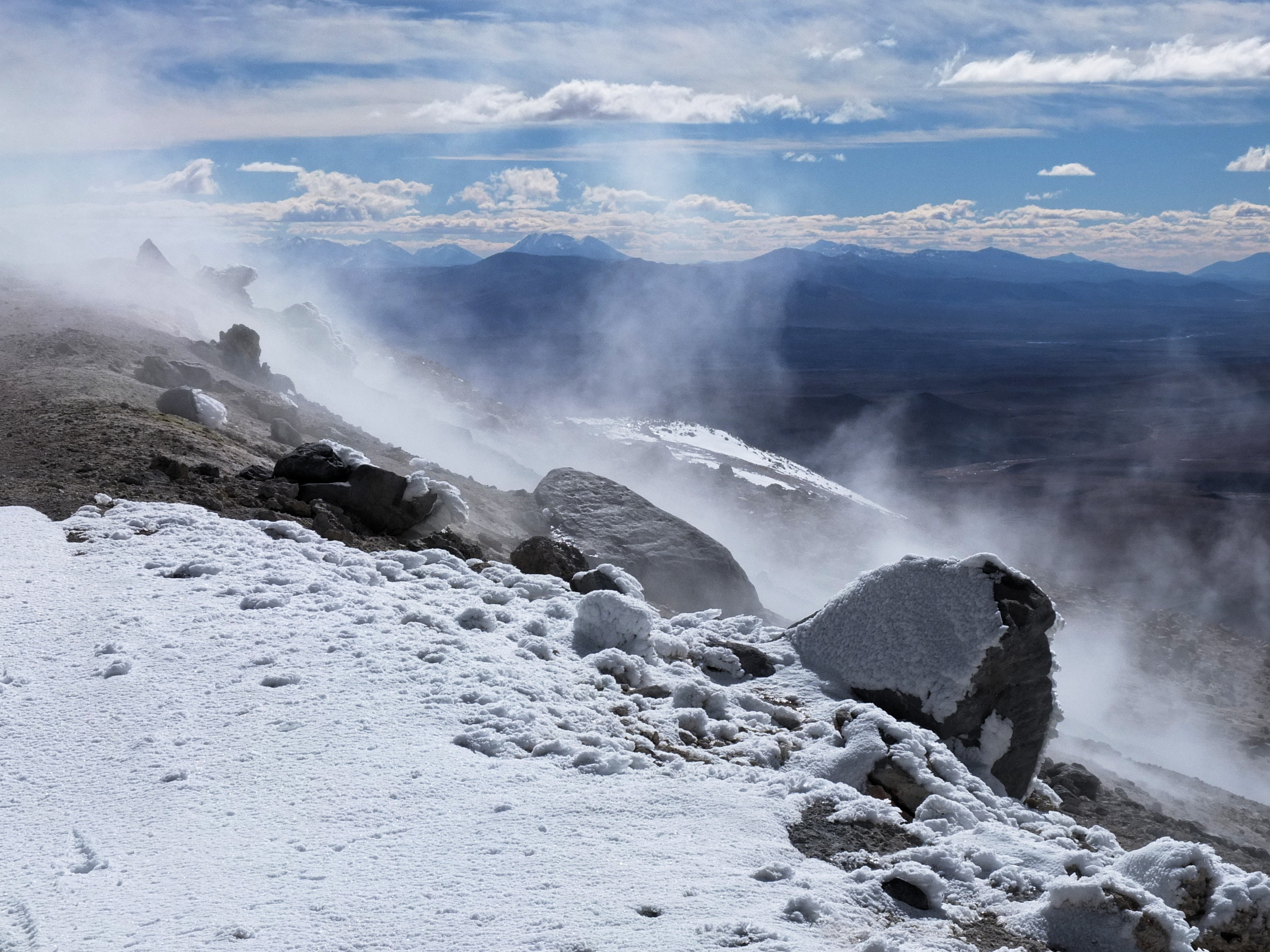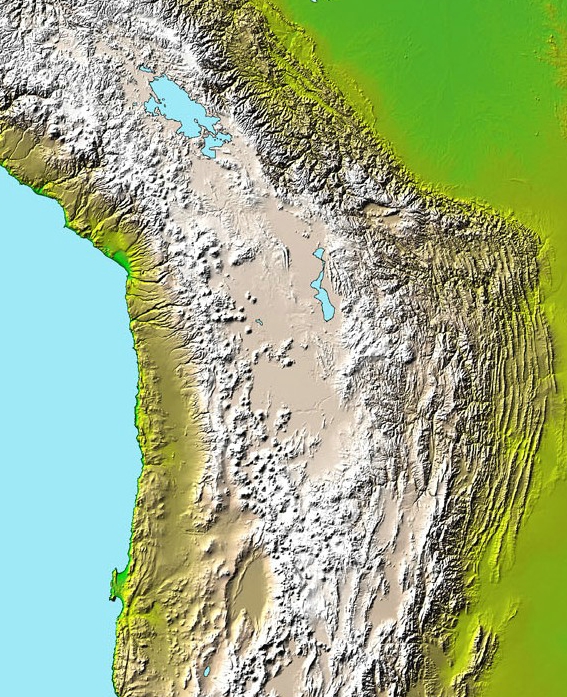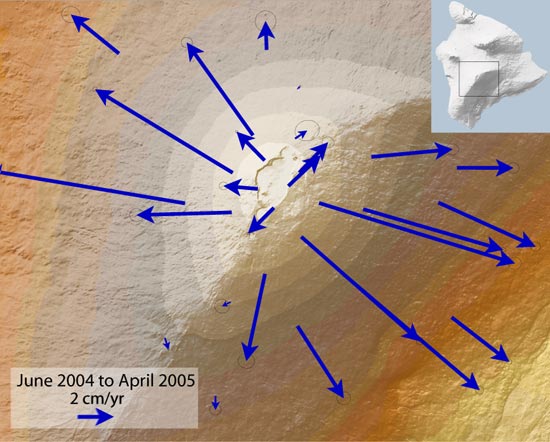|
Uturuncu
Uturuncu is a dormant volcano in the Sur Lípez Province of Bolivia. It is high, has two summit peaks, and consists of a complex of lava domes and lava flows with a total volume estimated to be . It bears traces of a former glaciation, even though it does not currently carry glaciers. Volcanic activity took place during the Pleistocene epoch and the last eruption was 250,000 years ago; since then Uturuncu has not erupted but active fumaroles occur in the summit region, between the two summits. The volcano rises within the Altiplano–Puna volcanic complex, a larger province of large volcanoes and calderas which over the last few million years (mya) have emplaced about of ignimbrites in sometimes very large eruptions. Underneath it lies the so-called Altiplano–Puna magmatic body, a large sill formed by partially molten rocks. Starting in 1992, satellite observations have indicated a large area of regional uplift centered on Uturuncu, which has been interpreted as an indic ... [...More Info...] [...Related Items...] OR: [Wikipedia] [Google] [Baidu] |
Altiplano–Puna Magma Body
The Altiplano-Puna Magma Body (APMB), a magma body located within the Altiplano-Puna plateau approximately 10-20 km beneath the Altiplano-Puna Volcanic Complex (APVC) in the Central Andes. High resolution tomography shows that this magma body has a diameter of ~200 km, a depth of 14-20 km, with a total volume of ~500,000 km3, making it the largest known active magma body on Earth. Thickness estimates for the APMB are varied, with some as low as 1 km, others around 10-20 km, and some extending as far down as the Moho''.'' The APMB is primarily composed of 7-10 wt% water andesitic melts and the upper portion may contain more dacitic melts with partial melt percentages ranging from 10-40%. Measurements indicate that the region around the Uturuncu volcano in Bolivia is uplifting at a rate of ~10 mm/year, surrounded by a large region of subsidence. This movement is likely a result of the APMB interacting with the surrounding rock and causing deformation. Recent research demonstrates th ... [...More Info...] [...Related Items...] OR: [Wikipedia] [Google] [Baidu] |
Altiplano–Puna Volcanic Complex
The Altiplano–Puna volcanic complex (), also known as APVC, is a complex of volcanic systems in the Puna of the Andes. It is located in the Altiplano area, a highland bounded by the Bolivian Cordillera Real in the east and by the main chain of the Andes, the Western Cordillera, in the west. It results from the subduction of the Nazca Plate beneath the South American Plate. Melts caused by subduction have generated the volcanoes of the Andean Volcanic Belt including the APVC. The volcanic province is located between 21° S–24° S latitude. The APVC spans the countries of Argentina, Bolivia and Chile. In the Miocene–Pliocene (10-1 mya), calderas erupted felsic ignimbrites in four distinct pulses separated by periods of low levels of activity. At least three volcanic centres ( Guacha caldera, La Pacana, Pastos Grandes, Vilama) had eruptions of a Volcanic Exposivity Index (VEI) of 8, as well as smaller scale eruptive centres. Activity waned after 2 mya, but present- ... [...More Info...] [...Related Items...] OR: [Wikipedia] [Google] [Baidu] |
San Pablo De Lípez Municipality
San Pablo de Lípez Municipality is the first municipal section of the Sur Lípez Province in the Potosí Department in Bolivia. Its seat is San Pablo de Lípez. Geography The highest mountain of the municipality is Uturunku at . Other mountains are listed below: Subdivision The municipality consists of the following cantons: * Quetena Grande - 621 inhabitants (''2001'') * San Antonio de Lípez - 505 inhabitants * San Pablo de Lípez - 1,397 inhabitants The people The people are predominantly indigenous citizens of Quechua Quechua may refer to: *Quechua people, several indigenous ethnic groups in South America, especially in Peru *Quechuan languages, a Native South American language family spoken primarily in the Andes, derived from a common ancestral language **So ... descent.obd.descentralizacion.gov.bo/municipal/fichas/ (inactive) References External links San Pablo de Lípez Municipality: population data and map Municipalities of Potosí Department ... [...More Info...] [...Related Items...] OR: [Wikipedia] [Google] [Baidu] |
Ignimbrite
Ignimbrite is a type of volcanic rock, consisting of hardened tuff. Ignimbrites form from the deposits of pyroclastic flows, which are a hot suspension of particles and gases flowing rapidly from a volcano, driven by being denser than the surrounding atmosphere. New Zealand geologist Patrick Marshall (1869-1950) coined the term ''ignimbrite'' from the Latin ''igni-'' [fire] and ''imbri-'' [rain]. Ignimbrites are made of a very poorly sorted mixture of volcanic ash (or tuff when Lithification, lithified) and pumice lapilli, commonly with scattered lithic fragments. The ash is composed of glass shards and crystal fragments. Ignimbrites may be loose and unconsolidated, or lithified (solidified) rock called lapilli-tuff. Near the volcanic source, ignimbrites often contain thick accumulations of lithic blocks, and distally, many show meter-thick accumulations of rounded cobbles of pumice. Ignimbrites may be white, grey, pink, beige, brown, or black depending on their composition and d ... [...More Info...] [...Related Items...] OR: [Wikipedia] [Google] [Baidu] |
Realgar
Realgar ( ), also known as "ruby sulphur" or "ruby of arsenic", is an arsenic sulfide mineral with the chemical formula α-. It is a soft, sectile mineral occurring in monoclinic crystals, or in granular, compact, or powdery form, often in association with the related mineral, orpiment (). It is orange-red in color, melts at 320 °C, and burns with a bluish flame releasing fumes of arsenic and sulfur. Realgar is soft with a Mohs hardness of 1.5 to 2 and has a specific gravity of 3.5. Its streak is orange colored. It is trimorphous with pararealgar and bonazziite. Its name comes from the Arabic ''rahj al-ġār'' (, "powder of the mine"), via Medieval Latin, and its earliest record in English is in the 1390s. Uses Realgar is a minor ore of arsenic extracted in China, Peru, and the Philippines. Historical uses Realgar was used by firework manufacturers to create the color white in fireworks prior to the availability of powdered metals such as aluminium, magnesium and titani ... [...More Info...] [...Related Items...] OR: [Wikipedia] [Google] [Baidu] |
Sulfur
Sulfur (or sulphur in British English) is a chemical element with the symbol S and atomic number 16. It is abundant, multivalent and nonmetallic. Under normal conditions, sulfur atoms form cyclic octatomic molecules with a chemical formula S8. Elemental sulfur is a bright yellow, crystalline solid at room temperature. Sulfur is the tenth most abundant element by mass in the universe and the fifth most on Earth. Though sometimes found in pure, native form, sulfur on Earth usually occurs as sulfide and sulfate minerals. Being abundant in native form, sulfur was known in ancient times, being mentioned for its uses in ancient India, ancient Greece, China, and ancient Egypt. Historically and in literature sulfur is also called brimstone, which means "burning stone". Today, almost all elemental sulfur is produced as a byproduct of removing sulfur-containing contaminants from natural gas and petroleum.. Downloahere The greatest commercial use of the element is the production o ... [...More Info...] [...Related Items...] OR: [Wikipedia] [Google] [Baidu] |
Jaguar
The jaguar (''Panthera onca'') is a large cat species and the only living member of the genus '' Panthera'' native to the Americas. With a body length of up to and a weight of up to , it is the largest cat species in the Americas and the third largest in the world. Its distinctively marked coat features pale yellow to tan colored fur covered by spots that transition to rosettes on the sides, although a melanistic black coat appears in some individuals. The jaguar's powerful bite allows it to pierce the carapaces of turtles and tortoises, and to employ an unusual killing method: it bites directly through the skull of mammalian prey between the ears to deliver a fatal blow to the brain. The modern jaguar's ancestors probably entered the Americas from Eurasia during the Early Pleistocene via the land bridge that once spanned the Bering Strait. Today, the jaguar's range extends from core Southwestern United States across Mexico and much of Central America, the Amazon rainfo ... [...More Info...] [...Related Items...] OR: [Wikipedia] [Google] [Baidu] |
Deformation (volcanology)
In volcanology, deformation is any change in the shape of a volcano or the land surrounding it. This can be in the form of inflation, which is a response to pressurization, or deflation, which is a response to depressurization. Inflation is represented by swelling of the ground surface, a volcanic edifice, or a subsurface magma body. It can be caused by magma accumulation, exsolution of volatiles, geothermal processes, heating, and tectonic compression. Deflation is represented by shrinking of the ground surface, a volcanic edifice, or a subsurface magma body. It can be caused by magma withdrawal (related to intrusion or eruption), volatile escape, thermal contraction, phase changes during crystallization, and tectonic extension. Deformation is a key indicator of pre-eruptive unrest at many active volcanoes. The term bradyseism is used in the volcanological literature to mean the vertical ground movements associated with the Phlegraean Fields volcanic area west of Naples, Ital ... [...More Info...] [...Related Items...] OR: [Wikipedia] [Google] [Baidu] |
Eduardo Avaroa Andean Fauna National Reserve
The Eduardo Avaroa Andean Fauna National Reserve (''Reserva Nacional de Fauna Andina Eduardo Avaroa''; Spanish acronym: REA) is located in Sur Lípez Province. Situated in the far southwestern region of Bolivia, it is the country's most visited protected area. It is considered the most important protected area in terms of tourist influx in the Potosí Department. Located at an altitude between and in Bolivia, it extends over an area of and includes the Laguna Colorada National Wildlife Sanctuary. Categorized under IUCN Category IV, it is primarily for the protection of birds that inhabit the different lagoons in the reserve. The reserve protects part of the Central Andean dry puna (oligothermic) ecoregion. The reserve's major attractions are erupting volcanoes, hot springs, geysers, lakes, fumaroles, mountains and its three endemic species of flamingos in particular. History Established in 1973, the national park is named after Eduardo Avaroa (1838–1879), the Bolivian war ... [...More Info...] [...Related Items...] OR: [Wikipedia] [Google] [Baidu] |
Bolivia
, image_flag = Bandera de Bolivia (Estado).svg , flag_alt = Horizontal tricolor (red, yellow, and green from top to bottom) with the coat of arms of Bolivia in the center , flag_alt2 = 7 × 7 square patchwork with the (top left to bottom right) diagonals forming colored stripes (green, blue, purple, red, orange, yellow, white, green, blue, purple, red, orange, yellow, from top right to bottom left) , other_symbol = , other_symbol_type = Dual flag: , image_coat = Escudo de Bolivia.svg , national_anthem = " National Anthem of Bolivia" , image_map = BOL orthographic.svg , map_width = 220px , alt_map = , image_map2 = , alt_map2 = , map_caption = , capital = La Paz Sucre , largest_city = , official_languages = Spanish , languages_type = Co-official languages , languages ... [...More Info...] [...Related Items...] OR: [Wikipedia] [Google] [Baidu] |
San Pablo De Lípez
San Pablo de Lípez is a small town in the Potosí Department of Bolivia. It is the seat of the Sur Lípez Province and of the San Pablo de Lípez Municipality. See also * Kuntur Wasi (Bolivia), Kuntur Wasi * Q'illu Salli * Yana Urqu (Sud Lípez), Yana Urqu * Yuraq Urqu (Bolivia), Yuraq Urqu References Populated places in Potosí Department {{Potosí-geo-stub ... [...More Info...] [...Related Items...] OR: [Wikipedia] [Google] [Baidu] |






.jpg)